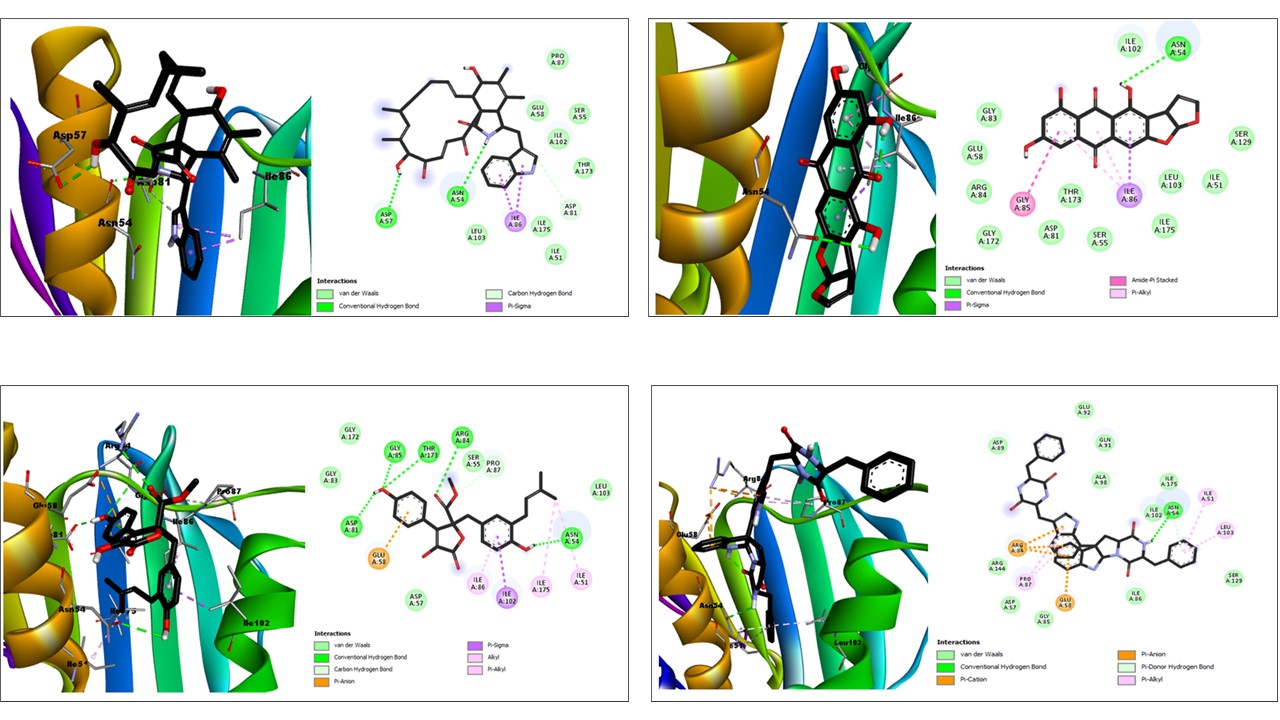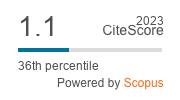Antimicrobial potential of Aspergillus fumigatiaffinis and A. sclerotiorum: Insights from in vitro and molecular docking investigations
DOI:
https://doi.org/10.55779/nsb16211862Keywords:
Aspergillus fumigatiaffinis, Aspergillus sclerotiorum, antimicrobial activity, molecular docking, secondary metabolitesAbstract
This study was conducted to evaluate the antimicrobial activity of metabolites produced by two Aspergillus species: A. fumigatiaffinis and A. sclerotiorum, against six bacterial strains and a yeast. An extraction of metabolites was carried out using three solvents, after selection of the best solvent, the obtained organic extracts were exposed to extreme conditions to test their stability. furthermore, three culture media with different compositions were used to select the best medium. The obtained results showed that the two Aspergillus species have interesting antimicrobial activity. Chloroform proved to be the best solvent for the extraction of bioactive metabolites. Additionally, the stability study showed that the majority of active extracts retain their activity after heat treatment (up to 100 °C) and exposure to light. However, the most suitable medium for antimicrobial activity was PDB. Molecular docking techniques were employed to explore the interactions between secondary metabolites from Aspergillus strains and the gyrase enzyme of Staphylococcus aureus, which was further supported by in vitro tests demonstrating strong antimicrobial activity of Aspergillus strains extracts against this bacterium. Docking analysis revealed compelling binding affinities of selected Aspergillus-derived secondary metabolites to the gyrase enzyme active site, characterized by diverse interaction patterns. These interactions offer insights into potential inhibitory effects on the gyrase enzyme, and suggest promising avenues for the development of therapeutic interventions against S. aureus infections.
Metrics
References
Al-Shaibani Abdulwahid BA, Al-Shakarchi Faiz I, Ameen Rasha S (2013). Extraction and characterization of antibacterial compound from Aspergillus niger. Journal of Al-Nahrain University 16(4):167-174. https://anjs.edu.iq/index.php/anjs/article/view/550/492
Awad G (2005). Caractérisation et étude de l’effet des sources de carbone et d’azote sur la production de nouveaux métabolites secondaires chez Aspergillus ochraceus non producteur de l’ochratoxine A. [Characterization and study of the effect of carbon and nitrogen sources on the production of new secondary metabolites in Aspergillus ochraceus which does not produce ochratoxin A]. PhD Thesis. National Polytechnic Institute, Toulouse. https://oatao.univ-toulouse.fr/7700/1/awad.pdf
Balasubramaniyam T, Choi SR, Nathan VK, Basu A, Lee JH (2023). A new perspective on metabolites and bioactive compounds from fungi. The American Journal of Chinese Medicine 51(07):1795-1821. https://doi.org/10.1142/s0192415x23500799
Boughachiche F (2012). Étude de molécules antibiotiques secrétées par des souches appartenant au genre Streptomyces, isolées de Sebkha. [Study of antibiotic molecules secreted by strains belonging to the Streptomyces genus, isolated from Sebkha]. PhD Thesis. University Mentouri Constantine. https://bu.umc.edu.dz/theses/biologie/BOU6205.pdf
Bramki A, Frahtia M, Jaouani A, Dahimat L, Kacem Chaouche N (2019). Extraction and preliminary study of antibacterial compounds of three species of Aspergillus genus. Asia-Pacific Journal of Molecular Biology and Biotechnology 27(2):26-34. http://dx.doi.org/10.35118/apjmbb.201.027.2.04
Breijyeh Z, Jubeh B, Karaman R (2020). Resistance of gram-negative bacteria to current antibacterial agents and approaches to resolve it. Molecules 25(6):1340. https://doi.org/10.3390/molecules25061340
Chaudhari V, Gosai H, Raval S, Kothari V (2014). Effect of certain natural products and organic solvents on quorum sensing in Chromobacterium violaceum. Asian Pacific Journal of Tropical Medicine 7:S204-S211. https://doi.org/10.1016/s1995-7645(14)60233-9
Gasparetti C, Faccio G, Arvas M, Buchert J, Saloheimo M, Kruus K (2010). Discovery of a new tyrosinase-like enzyme family lacking a C-terminally processed domain: production and characterization of an Aspergillus oryzae catechol oxidase. Applied Microbiology and Biotechnology 86 (1):213-226. https://doi.org/10.1007/s00253-009-2258-3
Gesheva V, Ivanova V, Gesheva R (2005). Effects of nutrients on the production of AK-111-81 macrolide antibiotic by Streptomyces hygroscopicus. Microbiological Research 160:243-248. https://doi.org/10.1016/j.micres.2004.06.005
Ghorri S (2015). Isolement des microorganismes possédant une activité anti- Fusarium. [Isolation of microorganisms possessing anti-Fusarium activity]. PhD Thesis. University Mentouri Constantine. https://bu.umc.edu.dz/theses/biologie/GHO6792.pdf
Jawad A, Zafar I (2017). Effect of Growth Conditions on Antibacterial Activity of Trichoderma harzianum against Selected Pathogenic Bacteria. Sarhad Journal of Agriculture 33(4):501-510. http://dx.doi.org/10.17582/journal.sja/2017/33.4.501.510
Kalyanasundaram I, Nagamuthu J, Muthukumaraswamy S (2015). Antimicrobial activity of endophytic fungi isolated and identified from salt marsh plant in Vellar Estuary. Journal of Microbiology and Antimicrobials 7(2):13-20. http://dx.doi.org/10.5897/JMA2014.0334
Kamat S, Kumari M, Taritla S, Jayabaskaran C (2020). Endophytic fungi of marine alga from Konkan Coast, India-A rich source of bioactive material. Frontiers in Marine Science 7(31). https://doi.org/10.3389/fmars.2020.00031
Kitouni M (2007). Isolement des bactéries actinomycétales productrices d’antibiotiques à partir d’écosystèmes extrêmes. Identification moléculaire des souches actives et caractérisation préliminaire des substances élaborées. [Isolation of antibiotic-producing actinomycetal bacteria from extreme ecosystems. Molecular identification of active strains and preliminary characterization of the substances produced]. PhD Thesis. University Mentouri Constantine. https://bu.umc.edu.dz/theses/biologie/KIT5003.pdf
Moroh JA (2013). Résistance bactérienne et phytomolécules antimicrobiennes issues de Morinda morindoides. [Bacterial resistance and antimicrobial phytomolecules from Morinda morindoides]. PhD Thesis. Western Brittany University. Brest. https://theses.hal.science/tel-00935393/document
Ogbole OO, Adebayo-Tayo BC, Salawu KM, Okoli VC (2017). Molecular identification and antimicrobial activity of endophytic fungi Aspergillus tamarii (trichomaceae). Nigerian Journal of Pharmaceutical Research 6(1):41-48. https://www.researchgate.net/publication/348923135
Orfali R, Aboseada MA, Abdel-Wahab NM, Hassan HM, Perveen S, Ameen F, … Abdelmohsen UR (2021). Recent updates on the bioactive compounds of the marine-derived genus Aspergillus. RSC Advances 11(28):17116-17150. https://doi.org/10.1039/D1RA01359A
Padalia H, Chanda S (2015). Antimicrobial efficacy of different solvent extracts of Tagetes erecta L. flower, alone and in combination with antibiotics. Applied Microbiology 1(1):1-10. http://dx.doi.org/10.4172/2471-9315.1000106
Padhi S, Das D, Panja S, Tayung K (2017). Molecular characterization and antimicrobial activity of an endolichenic fungus, Aspergillus sp. isolated from Parmelia caperata of Similipal Biosphere Reserve, India. Interdisciplinary Sciences: Computational Life Sciences 9(2):237-246. https://doi.org/10.1007/s12539-016-0146-y
Pasqualotto AC (2009). Differences in pathogenicity and clinical syndromes due to Aspergillus fumigatus and Aspergillus flavus. Medical Mycology 47:S261-S270. https://doi.org/10.1080/13693780802247702
Prabavathy D, Valli Nachiyar C (2012). Study on the antimicrobial activity of Aspergillus sp. isolated from Justicia adathoda. Indian Journal of Science and Technology 5(9):3317-3320. http://dx.doi.org/10.17485/ijst/2012/v5i9/30679
Ruma K, Sunil K, Prakash HS (2013). Antioxidant, anti-inflammatory, antimicrobial and cytotoxic properties of fungal endophytes from Garcinia species. International Journal of Pharmacy and Pharmaceutical Sciences 5(3):889-897. https://www.researchgate.net/publication/267036276
Sadorn K, Saepua S, Boonyuen N, Laksanacharoen P, Rachtawee P, Prabpai S, Kongsaeree P, Pittayakhajonwut P (2016). Allahabadolactones A and B from the endophytic fungus, Aspergillus allahabadii BCC45335. Tetrahedron 72(4):489‑495. https://doi.org/10.1016/j.tet.2015.11.056
Sadrati N, Zerroug A, Demirel R, Harzallah D (2023). Anti-multidrug-resistant Staphylococcus aureus and anti-dermatophyte activities of secondary metabolites of the endophytic fungus Penicillium brevicompactum ANT13 associated with the Algerian endemic plant Abies numidica. Archives of Microbiology 205(4):110. https://doi.org/10.1007/s00203-023-03452-9
Saiki AYC, Shen LL, Chen CMC, Baranowski J, Lerner CG (1999). DNA cleavage activities of Staphylococcus aureus gyrase and topoisomerase IV stimulated by quinolones and 2-Pyridones. Antimicrobial Agents in Chemotherapy 43(7):1574-1577. https://doi.org/10.1128/aac.43.7.1574
Schügerl K (2013). Solvent extraction in biotechnology: recovery of primary and secondary metabolites. (1994th ed), Springer Science & Business Media.
Shahid MG, Nadeem M (2015). Screening of Penicillium species and optimisation of culture conditions for the production of ergot alkaloids using surface culture fermentation process. Pakistan Journal of Scientific and Industrial Research Series B: Biological Sciences 58(1):23-29. http://dx.doi.org/10.52763/PJSIR.BIOL.SCI.58.1.2015.23.29
Signoretto C, Canepari P, Stauder M, Vezzulli L, Pruzzo C (2012). Functional foods and strategies contrasting bacterial adhesion. Current Opinion in Biotechnology 23:160-167. https://doi.org/10.1016/j.copbio.2011.08.006
Singh RS, Bhari R, Kaur HP, Vig M (2010). Purification and characterization of a novel thermostable mycelial lectin from Aspergillus terricola. Applied Biochemistry and Biotechnology 162(5):1339-1349. https://doi.org/10.1007/s12010-009-8906-3
Stancu MM (2016). Response mechanisms in Serratia marcescens IBB Po15 during organic solvents exposure. Current Microbiology 73:755-765. https://doi.org/10.1007/s00284-016-1108-7
Trott O, Olson AJ (2010). AutoDock Vina: improving the speed and accuracy of docking with a new scoring function, efficient optimization, and multithreading. Journal of Computational Chemistry 31:455-461. https://doi.org/10.1002/jcc.21334
Zerroug A (2011). Métabolites secondaires bioactifs des champignons endophytes isolés de Retama raetam (Forssk.). [Bioactive secondary metabolites of endophytic fungi isolated from Retama raetam (Forssk.)]. PhD Thesis. University Ferhat Abbas Setif. https://mmagister.univ-setif.dz/images/facultes/SNV/2009/zerroug%20amina.pdf
Zhu J, Song L, Shen S, Fu W, Zhu Y, Liu L (2023). Bioactive alkaloids as secondary metabolites from plant endophytic Aspergillus genus. Molecules 28(23):77-89. https://doi.org/10.3390/molecules28237789

Downloads
Published
How to Cite
Issue
Section
License
Copyright (c) 2024 Amina BRAMKI, Ouided BENSLAMA, Noureddine RAHIM, Sana GHORRI, Meriem BOUCHAIR, Bochra MAMERI

This work is licensed under a Creative Commons Attribution 4.0 International License.
Papers published in Notulae Scientia Biologicae are Open-Access, distributed under the terms and conditions of the Creative Commons Attribution License.
© Articles by the authors; licensee SMTCT, Cluj-Napoca, Romania. The journal allows the author(s) to hold the copyright/to retain publishing rights without restriction.
License:
Open Access Journal - the journal offers free, immediate, and unrestricted access to peer-reviewed research and scholarly work, due SMTCT supports to increase the visibility, accessibility and reputation of the researchers, regardless of geography and their budgets. Users are allowed to read, download, copy, distribute, print, search, or link to the full texts of the articles, or use them for any other lawful purpose, without asking prior permission from the publisher or the author.













.png)















